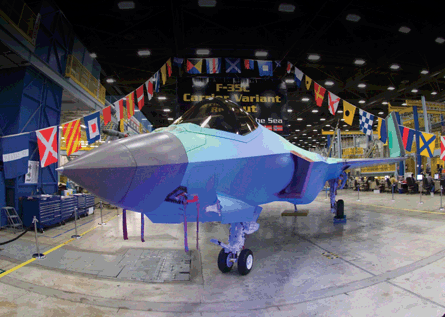Lockheed Martin on 28 July formally unveiled the last of the three flight-test variants in the F-35 Joint Strike Fighter programme, the heavier carrier version that is suddenly drawing increasing interest from the US Navy.
In a private briefing shortly before the roll-out ceremony, Lockheed told chief of naval operations (CNO) Adm Gary Roughead how the programme could support a USN proposal to accelerate production by 20-30 F-35Cs over the next six years.
 |
|---|
© Lockheed Martin
|
"We have a chart we showed the CNO that shows how much capacity could be applied to an accelerated navy buy if they chose to do so," says Dan Crowley, Lockheed's executive vice-president and general manager for the F-35.
Navy officials are considering a faster production run to help shrink a growing gap in its carrier-based fleet of Boeing F/A-18C/D Hornets and E/F Super Hornets. If approved, the acceleration would come on top of the 28 F-35s added to the US military's six-year budget plan, which Secretary of Defense Robert Gates revealed on 6 April.
"What we've heard is the [US] air force would like to increase their peak rate [starting in fiscal year 2016] from 80 per year to 110, and the navy would like to go from 50 a year [at peak rate] to 60 per year," Crowley says.
Such a plan would accelerate the Department of Defense's annual F-35 purchases from 130 aircraft to 170, with potentially dozens of aircraft ordered by foreign customers added to the yearly total. It is not clear how the acceleration strategy could be accommodated, amid long-term projections of stable or shrinking defence spending.
The USN is buying 680 aircraft that are divided between F-35Cs and short take-off and vertical landing F-35Bs for the US Marine Corps. The breakdown of orders between the two has never been officially explained, but USMC officials have called for a minimum purchase of 420 F-35Bs.
Lockheed originally planned to fly the first F-35C "CF-1" for the first time in September. It had previously delayed the milestone event to late December, but Crowley says the debut sortie is likely to be in January 2010.
The manufacturer is also struggling to keep pace with the other variants, especially the STOVL prototype BF-1, which had been scheduled to return to flight last December after an engine design problem was fixed. A target date in late July has now been extended to mid-August, Crowley says.
However, BF-1 remains on track for demonstrating a vertical landing in late September or early October, Crowley says. But BAE Systems test pilot Graham Tomlinson says the critical event could slip to as late as November.
Source: Flight International



















